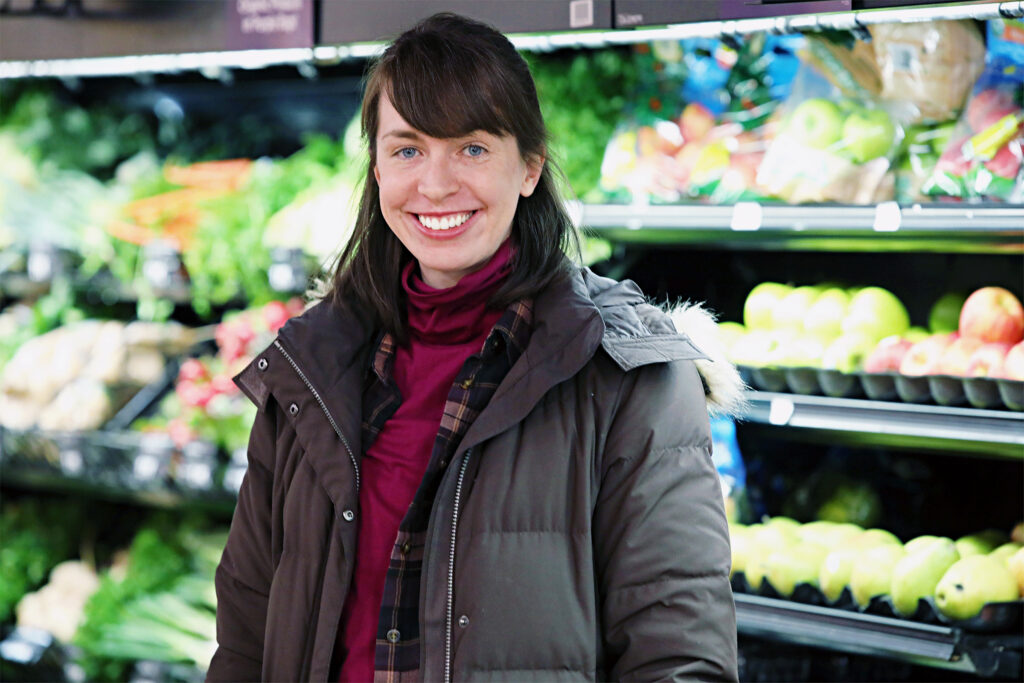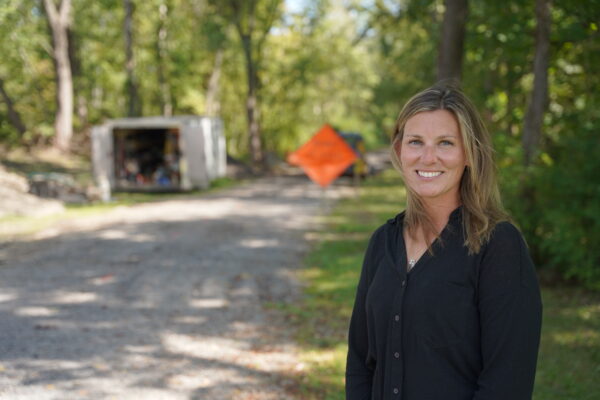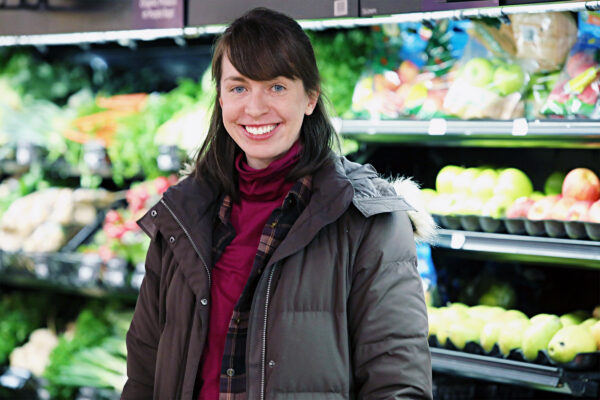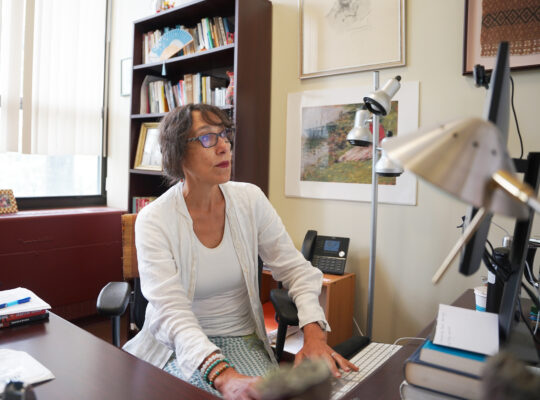
When talking with alumni about their Allegheny experience, whether they graduated in 1974 or 2024, one thing always stands out – the connection our alumni have with faculty. Our College has a rich legacy of faculty who go above and beyond in their interactions with students, serving as teachers, mentors, facilitators, career connectors, and more.
The Allegheny College Strategic Pathway goal of academic excellence and strong outcomes for every Allegheny student relies heavily on the continued creative and thoughtful work of our esteemed faculty. When speaking about our faculty, alumni often mention unique academic experiences outside of the classroom, experiences that allow them to collaborate with prominent civic leaders, conduct real-life data analysis with someone in another country, or get their hands dirty in a local stream. Additionally, faculty work behind the scenes, often in partnership with others, to build a more inclusive academic experience, whether it is by removing barriers for underrepresented students or producing open-access texts. This work demonstrates Allegheny’s commitment to a liberal arts education and serves as a critical component of our Strategic Pathway.
Everywhere you look on campus, you can find examples of faculty excellence in action. We’re proud to share some of those stories below.
Art and Urban Renewal
Paula Burleigh, Ph.D., assistant professor of art history, co-director of the public humanities program, and affiliated faculty of women’s, gender, and sexuality studies, led a faculty/student collaborative research project in summer 2023. She worked with three students who conducted a research project on public art and a feasibility study for a future public art stewardship program. It was a true Allegheny endeavor.
Chloe MacLaren ’24 (double major in environmental science and sustainability and art, science and innovation), Katie Duerig ’25 (double major in art, science, and innovation and German), and V Belcher ’26 (public humanities and philosophy) worked alongside Burleigh to develop a grant application with the Northwest Pennsylvania Investment Cooperative (NWPIC) to support a collaborative mural project in downtown Meadville at one of NWPIC’s cooperative-supported small business, Blissful Meads. Allegheny alumna Autumn Vogel ’15 served as the lead collaborator with the NWPIC.
As part of the project, students served as hands-on apprentices to lead artist Doug Eberhardt, a local artist and adjunct instructor in Allegheny’s Art Department. Burleigh says, “It was incredibly exciting to see the downtown mural come to fruition. This is not a simple process, and it was a valuable learning experience for our students to work with Doug to understand how a major public art project becomes a reality – there are a lot of moving parts, from design, to budget, to installation!” She notes that the NWPIC is an example of community members coming together, sharing resources and ideas to foster economic growth in Meadville, which benefits entrepreneurs and residents alike.
Eberhardt‘s mural, Blissful Bees, features a beehive, which is a model for what collaborative hard work can achieve.

Infrastructure and Greenspace
Students embarked on many exciting fieldwork projects during 2024, the 50th anniversary of the launch of Allegheny’s environmental science and sustainability (ESS) program. One example is a project led by Casey Bradshaw-Wilson, PhD., associate professor of environmental science & sustainability and co-director of the Watershed Conservation Research Center, who connected her ESS Junior Seminar classes with Zach Norwood, planning director of the Crawford County Planning Commission. As part of the project, students helped to create the infrastructure and greenspace along a new multipurpose trail being constructed in Meadville. This included identifying plants and wildflower mixes to use and locations to plan them. The students also recommended educational signage, animal boxes, a potential outdoor exercise park, and ideas for how to connect the trail to other places in Meadville. The project was prompted by a need the county identified.
“Student work included making connections and forming partnerships across the area; they reached out to other community members, with whom the College has partnered over many years, to help with the project, including Ernst Conservation Seed (the largest native seed producer and supplier in the eastern United States), Ernst Trail Association, and the Pennsylvania Game Commission,” Bradshaw-Wilson says. “Partnering with our community is a goal of Allegheny’s Strategic Pathway, so this type of work fits perfectly within the College’s efforts.”

Food Economics: Multifaceted Learning
Amelia Finaret, Ph.D., associate professor of global health and economics, delivers academic excellence by way of her Food Economics: Agriculture, Nutrition, and Health course. She says, “Allegheny students — and students everywhere in the world, really — care a lot about the food system. They come from many different disciplinary backgrounds and with interests such as public health, environmental science, psychology, biology, nutrition, and agronomy. Studying food economics allows them to engage in solving global problems and leveraging their existing knowledge and interests to do so.”
Finaret’s students embrace the connection between economics and food because it’s a universal issue. Economics is the study of how people choose among different options, and we all decide what to eat and how to eat multiple times every day, she says. Since many of these choices are observable, economics is particularly useful for studying choices related to producing and consuming food.
Based on her work in the course over the last nine years, Finaret published her own open-access textbook this year: “Food Economics: Agriculture, Nutrition, and Health.” Available on SpringerLink, “Food Economics” provides a unified introduction to the economics of agricultural production, business decisions, consumer behavior, and the government policies that shape our food system. The textbook begins with economic principles derived using graphical techniques to explain and predict observed prices, quantities, and other outcomes as a result of individual choices influenced by market structure and public policies. The second half of the book explores available data globally and for the United States, covering a wide range of questions in agriculture and economic development, food marketing, and consumption.
“We wanted to publish it open access so that people around the world would have free and easy access to the material,” Finaret says. “The book covers everything about the food economy for students even if they have never taken an economics class. Typically, higher-level elective courses in economics are gatekept using intro-level classes, but this class, and the book that goes along with it, teaches the material without needing those prerequisites, allowing students from all majors and minors to learn food economics if they want.”

Ensuring STEM Access for All
In 2021 and 2022, Allegheny, led by a team of faculty in the natural sciences and mathematics, secured a Howard Hughes Medical Institute (HHMI) Inclusive Excellence grant, which advances the discovery and sharing of scientific knowledge for all. This work has evolved over the years and has led to becoming part of a learning community with other academic institutions, including Auburn University at Montgomery, California State University East Bay (CSUEB), Mount Holyoke College, and Vanderbilt University. The team has been exploring how each institution can best increase its capacity for inclusion of all students in science, particularly underrepresented students.
According to Tim Chapp, Ph.D., associate professor of chemistry and grant project director, after graduation, students who go into STEM fields will be in situations where they’re solving problems on a daily basis, and solutions to those problems do not fit solely within disciplinary boxes. This is where a strong liberal arts education becomes essential, instilling the ability to think broadly and draw on concepts and ideas from multiple disciplines. This counters “deficit thinking.” Overall, Chapp says, deficit thinking is a framing device; it amounts to viewing a student’s difficulties from a “glass half-empty” perspective. Because deficit thinking focuses so much on a student’s “deficiencies,” while doing little to help with these issues, the student may feel hopeless and overwhelmed, causing them to feel these deficiencies are inherent.
“Deficit thinking is ubiquitous in higher education, and presents an obstacle to inclusive excellence,” said Chapp. “Additionally, deficit models have not been effective in addressing racial/ethnic persistence gaps in STEM fields in the past 25 years. We hope that our achievement-oriented approach – which focuses on what we want students to learn and take away from our courses – will improve outcomes for all students.”
The project mainly impacts students in biology, chemistry, biochemistry, mathematics, and physics who enroll in introductory STEM courses across these disciplines. The work is focused on addressing a fundamental question: “What would it take for institutions to make a comprehensive shift from deficit- to achievement-oriented frameworks in their approaches to the introductory science experience?” With this approach, faculty hope to develop a more inclusive STEM curriculum and achieve our goal of ensuring that all Allegheny students feel they belong in, and can be successful in, STEM classrooms.

Criminal Violence through a Liberal Arts Lens
Professor of Political Science Shannan Mattiace, Ph.D., has focused her work over the last decade on criminal violence in Mexico. Most recently, she has worked with Andy Bloeser, Ph.D., associate professor of political science and director of the Allegheny College Center for Political Participation; two Mexican political scientists and co-authors, Sandra Ley at the Tecnológico de México and Guillermo Trejo at the University of Notre Dame; and two Catholic church human rights organizations, CIAS por la Paz (Jesuits) and SERAPAZ (Dominican). Their work required a large amount of data interpretation, which two Allegheny students were prepared to tackle.
In the summer of 2024, Caroline Maye ’26, a political science major with a history minor, and Jess Bickart ’26, a political science major and community and justice studies minor, worked on interpreting a major survey that Trejo and Mattiace conducted, through a team, about rural peoples’ trust in the regular police versus the community police systems. The students took stock of the data and presented preliminary interpretations, with Maye’s skills in regression and statistical analysis proving to be critical in analyzing the data. The students’ work will be included in a book Mattiace is writing with Trejo, tentatively titled “Indigenous Resistance to Narco Violence.”
Mattiace says, “Criminal violence is a very interdisciplinary field, so being at a liberal arts school is helpful in that we are used to looking at problems from a range of different angles and disciplines. When I teach sections on criminal violence in my comparative politics courses, I often assign academic pieces from sociology, anthropology, and economics journals. Students are very agile in being able to move from discipline to discipline and insight to insight in order to try to understand this complex and multi-layered issue.”
The Allegheny Difference
These are just a small handful of academic excellence examples and extraordinary outcomes delivered by a liberal arts education at Allegheny. Faculty, alumni, and students work together to ask questions, find answers, and make an impact on the community around them. At the end of our students’ four-year journey, Allegheny faculty have prepared our graduates to enter the world with a fully rounded liberal arts perspective as problem-solvers, creative thinkers, and disciplined workers.


